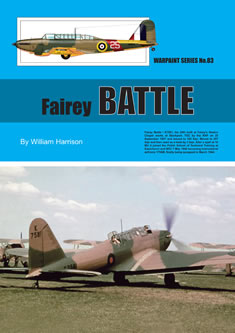
- Ship to United States
Schnellsuche
Öffnungszeiten während der Feiertage
Geänderte oder bestätigte Öffnungszeiten des Luchtvaart Hobby Shops in Aalsmeerderbrug an folgenden Tagen:
Aviation Megastore website is available without limitations. Orders are processed during shop operating hours.
| Mo | 9 Juni | Geschlossen: Whit Monday |
Fairey Battle
Product-Code WS-83
Fairey
€ 15,55
Serie Warpaint Series No 83
Verlag/Marke Hall Park
Schriftsteller William Harrison
Format a4
Seiten 60
Ausfúhrung Soft cover
Sprache English
Kategorie Luftfahrtbücher
Unterkategorie WW2 UK » WW2 UK Aircraft
Vorrat nur 2 verbleibende
Diese Artikel ist in unserer Datenbank aufgenommen am Freitag 5. August 2011.
Your reliable Aviation Book Source since 1989
Auch in dieser Reihe:
| Artikel | Verlag/Marke | Serie/Maßstab | Preis € | ||
 | Armstrong Whitworth Albermarle | Hall Park | Warpaint Series No 115 | € 15,55 | |
 | Cessna T37A/B/C 'Tweet' and the A37A/B 'Dragonfly' | Hall Park | Warpaint Series No 127 | € 22,89 | |
 | Douglas A20 Boston / Havoc | Hall Park | Warpaint Series No 32 | € 15,55 | |
 | English Electric Canberra | Hall Park | Warpaint Series No 60 | € 20,14 | |
 | Grumman A-6 Intruder & EA-6B Prowler | Hall Park | Warpaint Series No 146 | € 21,06 | |
 | Grumman F9F Panther | Hall Park | Warpaint Series No 119 | € 18,30 | |
 | Hawker Sea Fury | Hall Park | Warpaint Series No 16 | € 13,72 | |
 | Lockheed F104 Starfighter | Hall Park | Warpaint Series No 43 | € 17,39 | |
 | Republic F105 Thunderchief | Hall Park | Warpaint Series No 38 | € 15,55 | |
 | Westland Scout & Wasp | Hall Park | Warpaint Series No 110 | € 16,47 |
Produktbeschreibung
The Fairey Battle was not a failure!
British Prime Minister, Winston Churchill, said in the House of Commons on 20 August, 1940 - ....'on no part of the RAF does the weight of war fall more heavily than on the daylight bomber'.... . A reflection of what happened in the Low Countries during May/June 1940. The Battle was not mis-used during this debacle. The Air Staff, before the war, had planned against such an attack by Germany through the Low Countries, the Blitzkrieg was just outside their experience and the light bombers were thrust in at low level against a rapidly moving and heavily armed enemy.
It is also unfair for aviation journalists to compare the performance of a Battle against the new emerging single-engined fighters. It was a large but graceful design, and by contemporary standards was advanced for its day. Originally conceived within the limits of the Geneva Disarmament Conference the Battle would, by the time the second world war opened, have over 1000 aircraft in RAF service providing vital aircrew experience of a modern monoplane with a retractable undercarriage, variable-pitch propellers and hydraulic systems.
After withdrawal from front line squadrons the Battle airframe was adapted to provide experimental test bed work and give trainee aircrews extensive flying training in the UK, Australia, Canada, South Africa and Southern Rhodesia. More than half of all Battles built were later used in the training role - many continuing in use until 1945 or after!
© 1989–2025 Luchtvaart Hobby Shop B.V.
